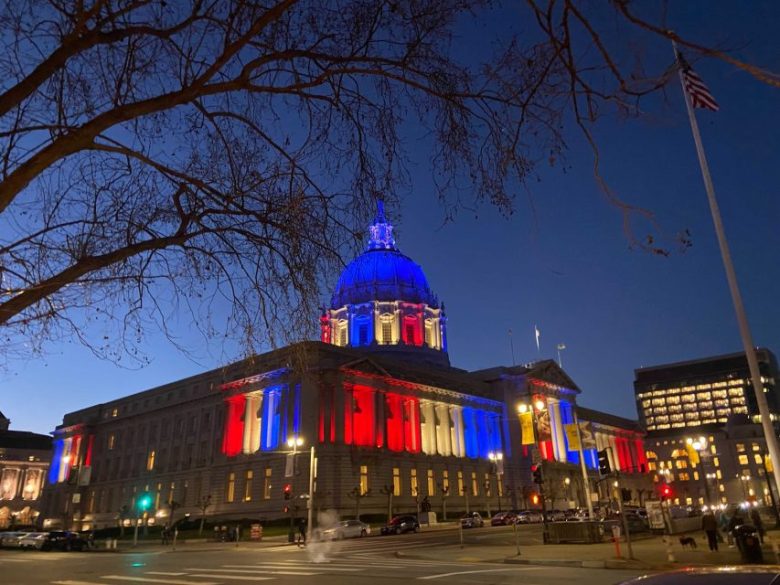Follow along for Mission Local’s live updates for Election Day from across San Francisco. For prior election blog updates from the last week, click here.
5 a.m.: Today is Election Day in San Francisco. Here’s what to expect.
Imagine a political campaign is like a ski ramp, with candidates gaining momentum before soaring off into the unknown.
If so, that would render Mark Farrell the Vinko Bogataj of the 2024 San Francisco mayoral campaign. You probably don’t know this name, but you probably do know who this is: He’s the Yugoslavian skier whose horrifying ski-jump-gone-wrong for many years defined “the agony of defeat” in the intro for “ABC Wide World of Sports.”
News broke yesterday — yes, the day before Election Day — that Farrell had agreed to pay the largest campaign finance-related fine in city history — some $108,000. At issue was his commingling of funds between a ballot measure committee and his mayoral committee so as to elude the $500 donation limit to the latter.
This is less-than-ideal timing for Farrell — but also less-than-coincidental: “The Enforcement Division did everything in its power to publicly resolve this case prior to Election Day so the public would have information about these violations when it matters most,” said Ethics Commission enforcement director Olabisi Matthews.
Ethics enforcement actions often take place years after the fact. This one was hustled into fruition with remarkable expediency.
But, for Farrell, it could’ve definitely been worse. He reached his settlement with Ethics on Oct. 25. But it wasn’t until Nov. 4 that the news went (very) public. By that time, more than half of San Francisco’s electorate may have already voted. And, importantly, some of the neighborhoods most likely to go for Farrell — among them District 7 and Farrell’s own District 2 — are overrepresented in early returns.
San Francisco elections are nerve-wracking, and today’s is more so than most — yes, there’s a concurrent federal election of some import. But when the initial round of votes drops tonight on or around 8:45 p.m., it’s important for emotionally frazzled denizens to keep in mind what we know and what we don’t know.
Department of Elections head John Arntz tells me that ballots received up until Sunday will be tabulated in the first drop. That’s just shy of 190,000 ballots — which is about 36 percent of registered city voters. There are probably as many or more votes to be counted starting later this week as all the votes to be tabulated on Tuesday.
The votes already in the can for tonight’s 8:45 p.m. reveal make up a mere down-payment of what’s to come and will not be representative of the total electorate. We’re telling you this now.
Regardless, the results of the early vote drops often befuddle voters. They are likely to be even more befuddled when the Department of Elections runs ranked-choice voting (RCV) tabulations on 36-odd percent of the ballots, which it will do at 8:45ish tonight.
When asked what the utility is of running ranked-choice voting with some two-thirds of the ballots outstanding, Arntz replied that this “was much requested by RCV advocates.” This is not surprising: RCV advocates love RCV with a monomaniacal zeal; if they were drowning on a sinking raft and a rescue ship approached, the RCV advocates would hold out that, what they really need in this situation, is ranked-choice voting.
As for the rest of us, it’s not clear what benefit there is to crunching the numbers and running ranked-choice voting tabulations at a highly preliminary point in voting returns. It adds a sense of finality to vote totals that are markedly incomplete; in the 2019 district attorney election, for example, the early RCV resulted in a runoff between Suzy Loftus and Nancy Tung, with Loftus being the winner.
This is a long, long way from how things turned out; Tung finished far out of the running and Chesa Boudin pipped Loftus at the RCV post.
Running RCV with many or even most of the votes unaccounted for results in unfounded elation or dejection — the misplaced thrill of victory or the unwarranted agony of defeat, you could say. But here’s the thing: Voters can cheer or boo at the changing results, but the outcome is already sealed. The votes are in, and all that remains is the counting. We can root for Vinko Bogataj to stick a perfect jump every time we see the old tape, but the outcome has already occurred — and is immutable.
There will be four updates today from the Department of Elections. The final update, which will come at perhaps around midnight, will include results from in-person voters at polling places.
The Department of Elections will run two RCV tabulations today: First on the initial tranche at 8:45 p.m. and then on the fourth batch — which includes all Election Day voters. Further updates will come every day at 4 p.m. starting Thursday.
 City Hall, illuminated in patriotic colors for San Francisco’s special election, Feb. 15, 2022. Photo by Annika Hom
City Hall, illuminated in patriotic colors for San Francisco’s special election, Feb. 15, 2022. Photo by Annika Hom
The Times They Are A-Changin’
Polls can give us some idea of what may unfold tonight. But there has never been an electorate this large in a San Francisco mayoral race, so it remains to be seen how closely real behavior tracks with predicted behavior.
And we’re going to have to wait to see this: With the ascent of universal voting by mail, predicting the flow of San Francisco elections has become much more erratic and difficult. It is, however, generally accepted that very early voters skew more conservative — which means a good early showing by Farrell is all the more critical for him. Being hit with a record ethics fine is a bad valediction for any campaign, so it’s all the more vital for Farrell to have done well with early voters who didn’t know about this before casting their ballots — especially when they figure to be his core voters.
After tonight’s first drop, things become more complicated. In the olden days, you’d have early absentee voters, who skewed more conservative, day-of-election voters, who skewed more liberal, and late absentee voters who were somewhere in-between. Predicting how votes would shift through the hours and days was, if not a science, something of an alchemy.
This is no longer the case. Voting patterns are just not nearly as easy to track — and even if later voters figure to be less conservative than the very earliest voters, it’s difficult to gauge by how much. As the vote comes in, we can track where in the city these ballots hailed from. But with fewer and fewer San Franciscans voting on Election Day on a machine, it’s much harder to know what parts of the city have yet to have their votes tabulated.
The Department of Elections will, slowly but surely, count all the votes. The only way out is through.
— Joe Eskenazi
Copyright for syndicated content belongs to the linked Source link




